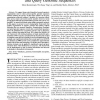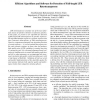BMCBI
2010
14 years 17 days ago
2010
Background: Traditional genome alignment methods consider sequence alignment as a variation of the string edit distance problem, and perform alignment by matching characters of th...
TITB
2008
14 years 2 months ago
2008
To support large-scale biomedical research projects, organizations need to share person-specific genomic sequences without violating the privacy of their data subjects. In the past...
NAR
1998
14 years 2 months ago
1998
The Saccharomyces Genome Database (SGD) provides Internet access to the complete Saccharomyces cerevisiae genomic sequence, its genes and their products, the phenotypes of its mut...
BMCBI
2005
14 years 3 months ago
2005
Background: Currently available methods to predict splice sites are mainly based on the independent and progressive alignment of transcript data (mostly ESTs) to the genomic seque...
JBCB
2006
14 years 3 months ago
2006
LTR retrotransposons constitute one of the most abundant classes of repetitive elements in eukaryotic genomes. In this paper, we present a new algorithm for detection of full-leng...
BMCBI
2006
14 years 3 months ago
2006
Background: Deluged by the rate and complexity of completed genomic sequences, the need to align longer sequences becomes more urgent, and many more tools have thus been developed...
BMCBI
2006
14 years 3 months ago
2006
Background: Genomic tiling micro arrays have great potential for identifying previously undiscovered coding as well as non-coding transcription. To-date, however, analyses of thes...
CSB
2003
IEEE
14 years 8 months ago
2003
IEEE
A new pattern filtering technique is developed to analyze the genomic sequence in this research based on gap sequences, in which the distance of the same symbol is recorded consec...
WABI
2009
Springer
14 years 9 months ago
2009
Springer
Recent high throughput sequencing technologies are capable of generating a huge amount of data for bacterial genome sequencing projects. Although current sequence assemblers succes...





